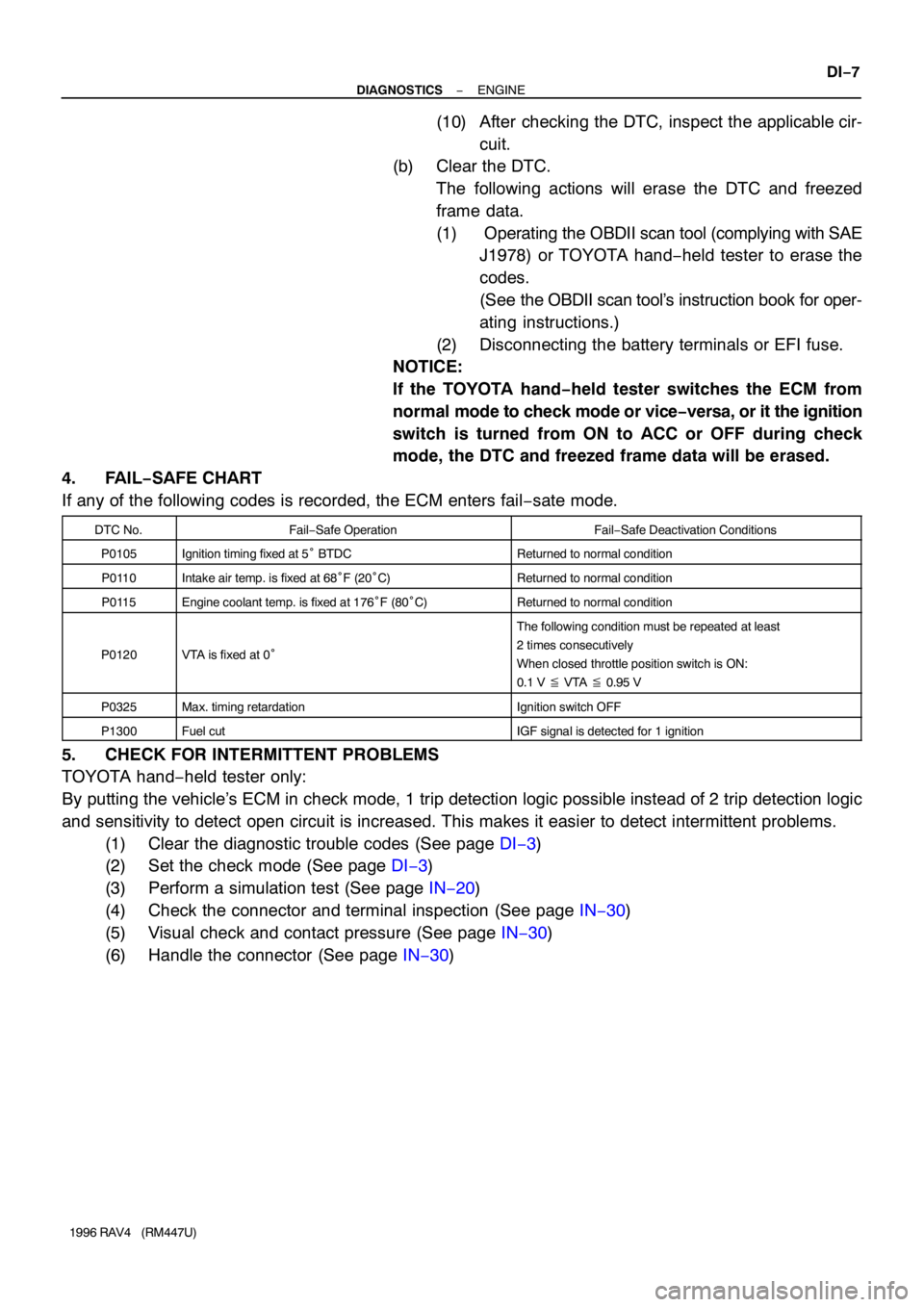Page 305 of 1354
CO0BK−01
S01348
CO−10
− COOLINGTHERMOSTAT
1996 RAV4 (RM447U)
REMOVAL
HINT:
Removal of the thermostat would have an adverse effect, caus-
ing a lowering of cooling efficiency. Do not remove the thermo-
stat, even if the engine tends to overheat.
1. DRAIN ENGINE COOLANT
2. REMOVE OIL FILTER (See page LU−2)
3. REMOVE WATER INLET AND THERMOSTAT
(a) Remove the 2 nuts, and disconnect the water inlet from
the water pump cover.
(b) Remove the thermostat.
(c) Remove the gasket from the thermostat.
Page 307 of 1354
CO0BM−02
P13611
Protrusion
Jiggle
Valve5° 5° CO−12
− COOLINGTHERMOSTAT
1996 RAV4 (RM447U)
INSTALLATION
1. PLACE THERMOSTAT IN WATER PUMP
(a) Install a new gasket to the thermostat.
(b) Align the jiggle valve of the thermostat with the protrusion
of the water inlet, and insert the thermostat in the water
inlet.
HINT:
The jiggle valve may be set within 5° of either side of the pre-
scribed position.
2. INSTALL WATER INLET AND THERMOSTAT
Install the water inlet and thermostat with the 2 nuts.
Torque: 8.8 N·m (90 kgf·cm, 78 in.·lbf)
3. INSTALL OIL FILTER (See page LU−2)
4. FILL WITH ENGINE COOLANT
5. START ENGINE AND CHECK FOR LEAKS
6. CHECK ENGINE OIL LEVEL
Page 309 of 1354

CO0BO−02
Z00570
Radiator Cap Tester
Radiator Cap30° or More
S01265
Radiator Cap Tester CO−14
− COOLINGRADIATOR
1996 RAV4 (RM447U)
ON−VEHICLE INSPECTION
1. REMOVE RADIATOR CAP
CAUTION:
To avoid the danger of being burned, do not remove the ra-
diator cap while the engine and radiator are still hot, as fluid
and steam can be blown out under pressure.
2. INSPECT RADIATOR CAP
NOTICE:
�If the radiator cap has contaminations, always rinse
it with water.
�When performing steps (a) and (b) below, keep the ra-
diator cap tester at an angle of over 30°above the hor-
izontal.
(a) Using a radiator cap tester, slowly pump the tester and
check that air is coming from the vacuum valve.
Pump speed:
1 push/(3 seconds or more)
NOTICE:
Push the pump at a constant speed.
If air is not coming from the vacuum valve, replace the radiator
cap.
(b) Pump the tester and measure the relief valve opening
pressure.
Pump speed:
1 push within 1 second
NOTICE:
This pump speed is for the first pump only (in order to close
the vacuum valve). After this, the pump speed can be re-
duced.
Standard opening pressure:
74 − 103 kPa (0.75 − 1.05 kgf/cm
2, 10.7 − 14.9 psi)
Minimum opening pressure:
59 kPa (0.6 kgf/cm
2, 8.5 psi)
HINT:
Use the tester’s maximum reading as the opening pressure.
If the opening pressure is less than minimum, replace the radia-
tor cap.
3. INSPECT COOLING SYSTEM FOR LEAKS
(a) Fill the radiator with coolant and attach a radiator cap tes-
ter.
(b) Warm up the engine.
(c) Pump it to 118kPa (1.2 kgf/cm
2, 17.1 psi), and check that
the pressure does not drop.
If the pressure drops, check the hoses, radiator or water pump
for leaks. If no external leaks are found, check the heater core,
cylinder block and cylinder head.
4. REINSTALL RADIATOR CAP
Page 311 of 1354

CO0BQ−03
S01355
S01278
w/ A/C
S01293
CO−16
− COOLINGRADIATOR
1996 RAV4 (RM447U)
REMOVAL
1. REMOVE ENGINE UNDER COVERS
2. DRAIN ENGINE COOLANT
3. w/ A/C:
REMOVE COOLER CONDENSER (See page AC−47)
4. REMOVE RADIATOR ASSEMBLY
(a) Disconnect the No.1 cooling fan connector.
(b) w/ A/C:
Disconnect the No.2 cooling fan connector.
(c) Disconnect the ECT switch connector for electric cooling
fan.
(d) Disconnect the engine wire clamp from No.1 cooling fan
shroud.
(e) Disconnect the upper radiator hose from radiator.
(f) Disconnect the lower radiator hose from radiator.
(g) Disconnect the radiator reservoir hose from radiator.
(h) Disconnect the 2 A/T oil cooler hoses from oil cooler
pipes.
(i) Remove the 2 bolts and 2 upper radiator supports.
Torque: 13 N·m (130 kgf·cm, 9 ft·lbf)
(j) Remove the radiator assembly.
HINT:
At the time of installation, plaese refer to the following items. Af-
ter installation, check that the rubber cushion (A) of the support
is not depressed.
(k) Remove the 2 lower radiator supports.
5. w/ A/C:
REMOVE NO.2 COOLING FAN FROM RADIATOR
Remove the 3 bolts and cooling fan.
Torque: 5.0 N·m (50 kgf·cm, 43 in.·lbf)
6. REMOVE NO.1 COOLING FAN FROM RADIATOR
Remove the 4 bolts and cooling fan.
Torque: 5.0 N·m (50 kgf·cm, 43 in.·lbf)
Page 313 of 1354

S01294
CO0BS−03
S01279
Disconnect
S01277
93°C
S01290
Ammeter
Battery
S01291
Ammeter
Battery CO−18
− COOLINGELECTRIC COOLING FAN
1996 RAV4 (RM447U)
ELECTRIC COOLING FAN
ON−VEHICLE INSPECTION
1. CHECK COOLING FAN OPERATION WITH LOW TEM-
PERATURE (Below 83°C (181°F))
(a) Turn the ignition switch ON.
(b) Check that the cooling fan stops.
If not, check the cooling fan relay and ECT switch, and check
for a separated connector or severed wire between the cooling
fan relay and ECT switch.
(c) Disconnect the ECT switch connector.
(d) Check that the cooling fan rotates.
If not, check the fan main relay, cooling fan relay, cooling fan,
fuses, and check for short circuit between the cooling fan relay
and ECT switch.
(e) Reconnect the ECT switch connector.
2. CHECK COOLING FAN OPERATION WITH HIGH TEM-
PERATURE (Above 93°C (199°F))
(a) Start the engine, and raise coolant temperature to above
93°C (199°F).
(b) Check that the cooling fan rotates.
If not, replace the ECT switch.
3. INSPECT NO.1 COOLING FAN
(a) Disconnect the cooling fan connector.
(b) Connect battery and ammeter to the cooling fan connec-
tor.
(c) Check that the cooling fan rotates smoothly, and check
the reading on the ammeter.
Standard amperage: 10.9 − 13.9 A
(d) Reconnect the cooling fan connector.
4. INSPECT NO.2 COOLING FAN
(a) Disconnect the cooling fan connector.
(b) Connect battery and ammeter to the cooling fan connec-
tor.
(c) Check that the cooling fan rotates smoothly, and check
the reading on the ammeter.
Standard amperage: 9.1 − 11.1 A
(d) Reconnect the cooling fan connector.
Page 320 of 1354
S01280ECT Switch
CO0BY−01
P05962
Ohmmeter
− COOLINGENGINE COOLANT TEMPERATURE (ECT) SWITCH
CO−25
1996 RAV4 (RM447U)
ENGINE COOLANT
TEMPERATURE (ECT) SWITCH
INSPECTION
1. DRAIN ENGINE COOLANT
2. REMOVE ECT SWITCH
3. INSPECT ECT SWITCH
(a) Using an ohmmeter, check that there is no continuity be-
tween the terminals when the coolant temperature is
above 93°C (199°F).
(b) Using an ohmmeter, check that there is continuity be-
tween the terminals when the coolant temperature is be-
low 83°C (181°F).
If continuity is not as specified, replace the switch.
4. REINSTALL ECT SWITCH
5. REFILL WITH ENGINE COOLANT
6. START ENGINE AND CHECK FOR COOLANT LEAKS
Page 324 of 1354

N09214
DLC 3 DI−4
− DIAGNOSTICSENGINE
1996 RAV4 (RM447U)
�By switching the ECM to check mode when trouble-
shooting, the technician can cause the MIL to light
up for a malfunction that is only detected once or
momentarily (TOYOTA hand−held tester only) (See
page DI−3).
�*2 trip detection logic:
When a logic malfunction is first detected, the mal-
function is temporarily stored in the ECM memory.
If the same malfunction is detected again during the
second drive test, this second detection causes the
MIL to light up.
�The 2 trip repeats the same mode a 2nd time. (How-
ever, the IG switch must be turned OFF between the
1st trip and 2nd trip).
�Freeze frame data:
Freeze frame data records the engine condition
when a misfire (DTC P0300 − P0304) or fuel trim
malfunction (DTC P0171, P0172), or other malfunc-
tion (first malfunction only), is detected.
�Because freeze frame data records the engine
conditions (fuel system, calculator load, engine
coolant temperature, fuel trim, engine speed, ve-
hicle speed, etc.) when the malfunction is detected,
when troubleshooting it is useful for determining
whether the vehicle was running or stopped, the en-
gine warmed up or not, the air−fuel ratio lean or rich,
etc. at the time of the malfunction.
�Priorities for Troubleshooting:
If troubleshooting priorities for multiple diagnostic
codes are given in the applicable diagnostic chart,
these should be followed.
If no instructions are given, troubleshoot DTC according to the
following priorities.
(1) DTC other than fuel trim malfunction (DTC P0171,
P0172), EGR (DTC P0401, P0402), and misfire
(DTC P0300 − P0304).
(2) Fuel trim malfunction (DTC P0171, P0172) and
EGR (DTC P0401, P0402).
(3) Misfire (DTC P0300 − P0304).
(b) Check the DLC3.
The vehicle’s ECM uses V.P.W. (Variable Pulse Width) for
communication to comply with SAE J1850. The terminal
arrangement of DLC3 complies with SAE J1962 and
matches the V.P.W. format.
Page 327 of 1354

− DIAGNOSTICSENGINE
DI−7
1996 RAV4 (RM447U)
(10) After checking the DTC, inspect the applicable cir-
cuit.
(b) Clear the DTC.
The following actions will erase the DTC and freezed
frame data.
(1) Operating the OBDII scan tool (complying with SAE
J1978) or TOYOTA hand−held tester to erase the
codes.
(See the OBDII scan tool’s instruction book for oper-
ating instructions.)
(2) Disconnecting the battery terminals or EFI fuse.
NOTICE:
If the TOYOTA hand−held tester switches the ECM from
normal mode to check mode or vice−versa, or it the ignition
switch is turned from ON to ACC or OFF during check
mode, the DTC and freezed frame data will be erased.
4. FAIL−SAFE CHART
If any of the following codes is recorded, the ECM enters fail−sate mode.
DTC No.Fail−Safe OperationFail−Safe Deactivation Conditions
P0105Ignition timing fixed at 5° BTDCReturned to normal condition
P0110Intake air temp. is fixed at 68°F (20°C)Returned to normal condition
P0115Engine coolant temp. is fixed at 176°F (80°C)Returned to normal condition
P0120VTA is fixed at 0°
The following condition must be repeated at least
2 times consecutively
When closed throttle position switch is ON:
0.1 V � VTA � 0.95 V
P0325Max. timing retardationIgnition switch OFF
P1300Fuel cutIGF signal is detected for 1 ignition
5. CHECK FOR INTERMITTENT PROBLEMS
TOYOTA hand−held tester only:
By putting the vehicle’s ECM in check mode, 1 trip detection logic possible instead of 2 trip detection logic
and sensitivity to detect open circuit is increased. This makes it easier to detect intermittent problems.
(1) Clear the diagnostic trouble codes (See page DI−3)
(2) Set the check mode (See page DI−3)
(3) Perform a simulation test (See page IN−20)
(4) Check the connector and terminal inspection (See page IN−30)
(5) Visual check and contact pressure (See page IN−30)
(6) Handle the connector (See page IN−30)